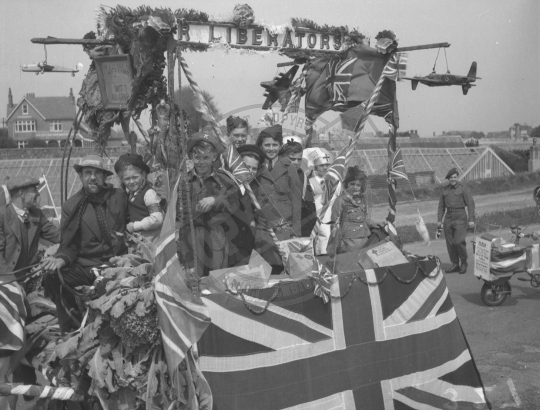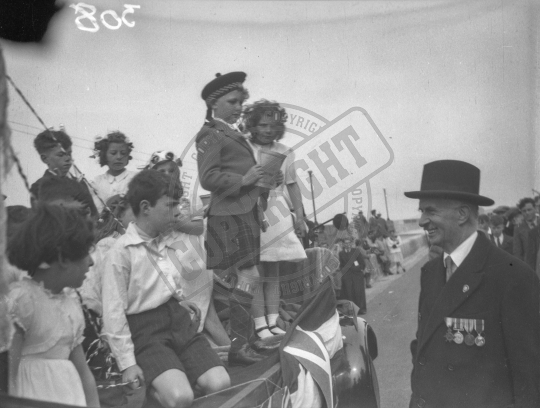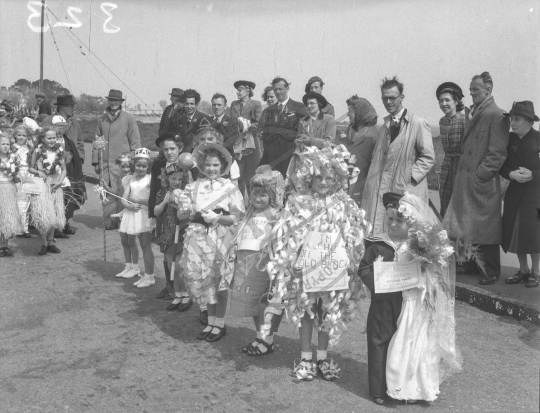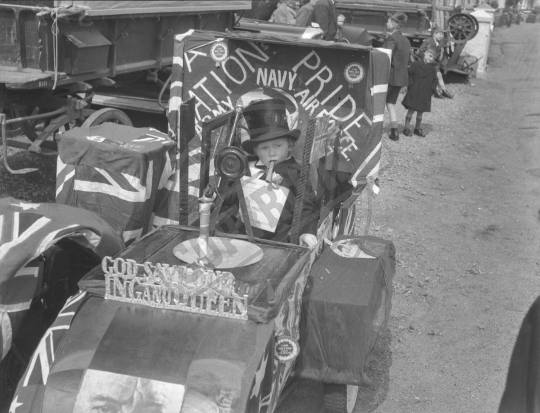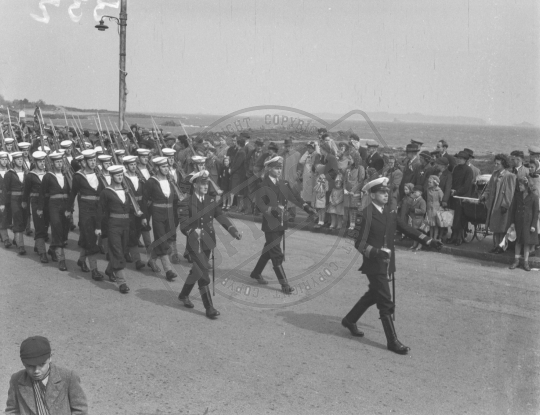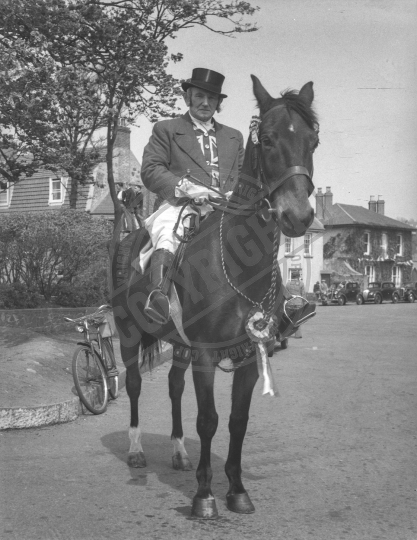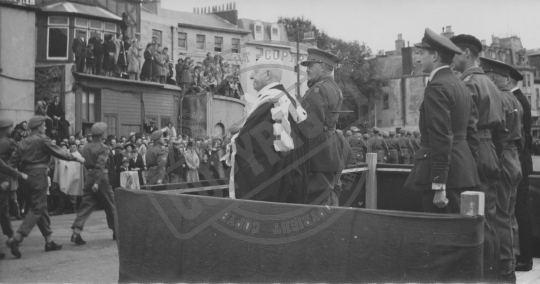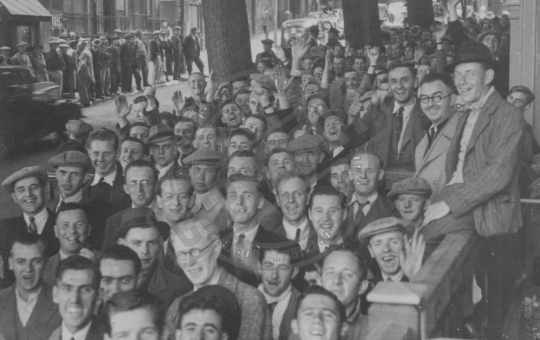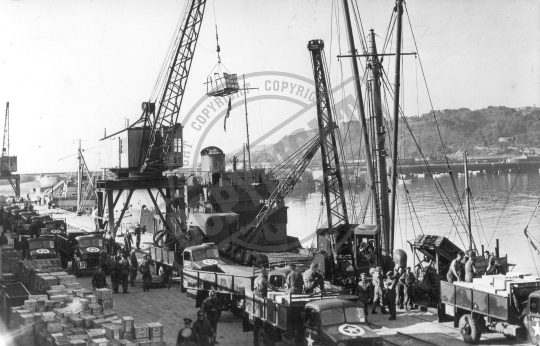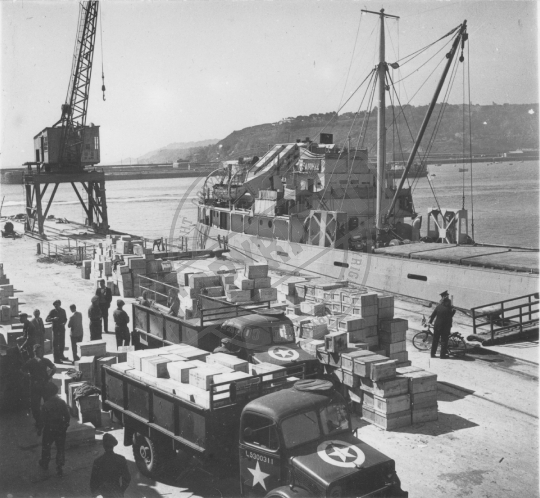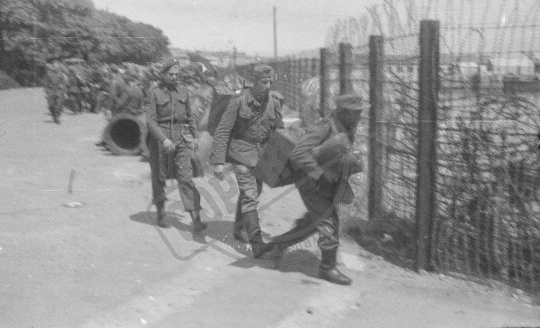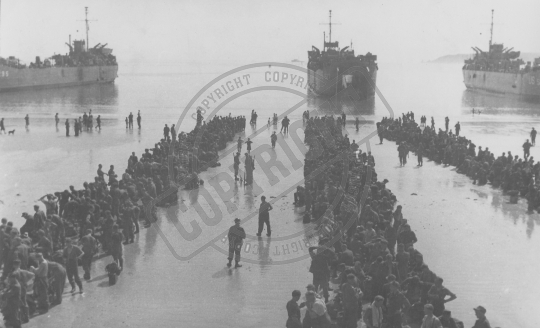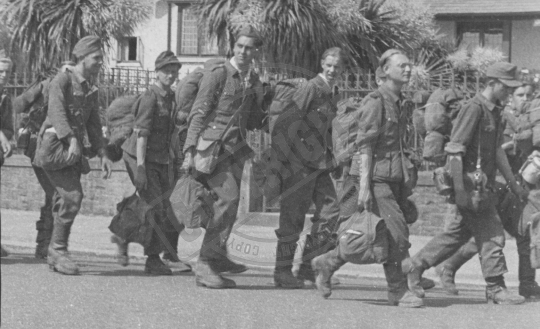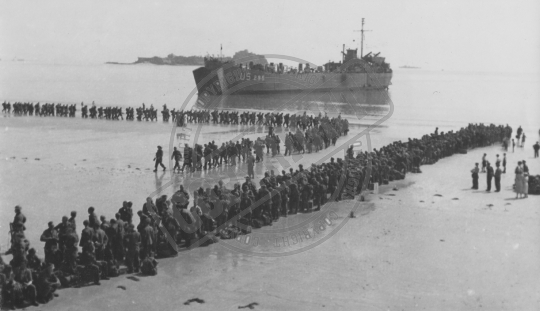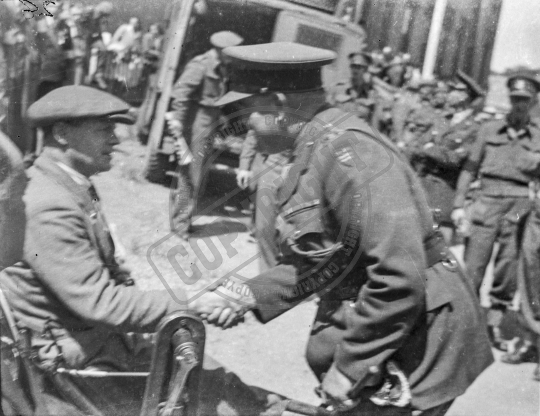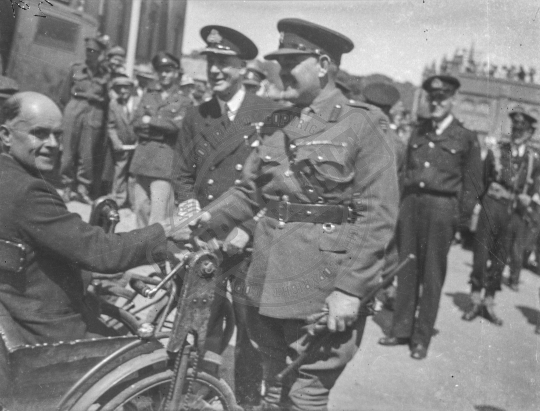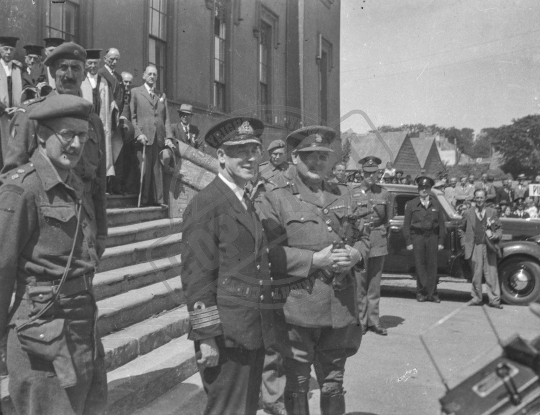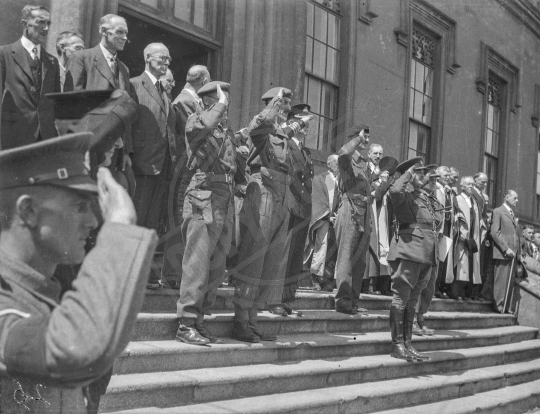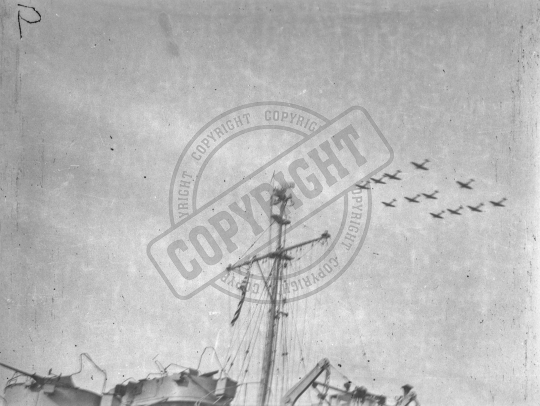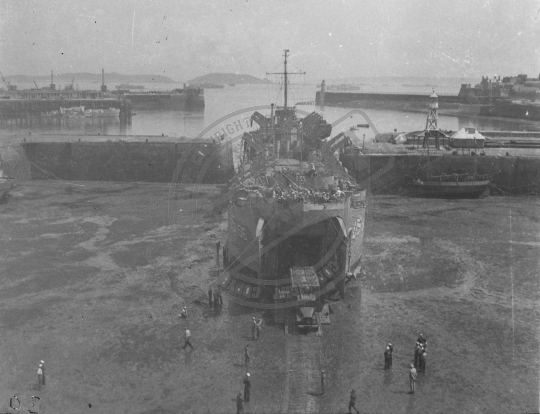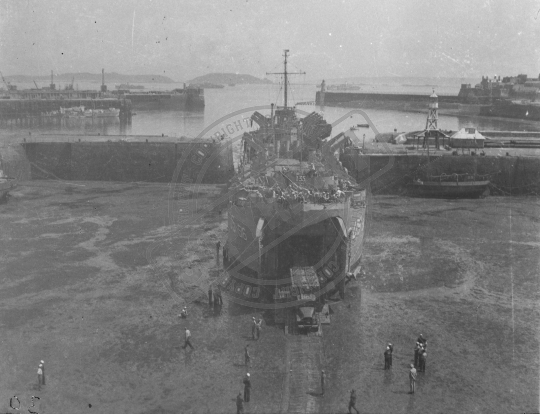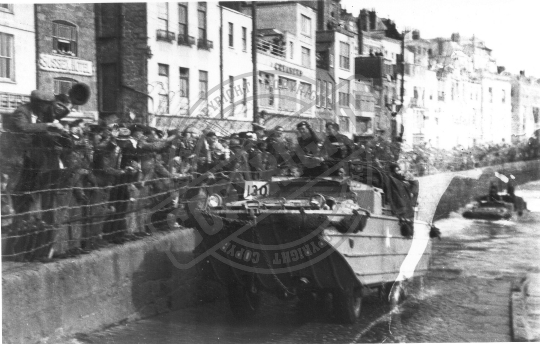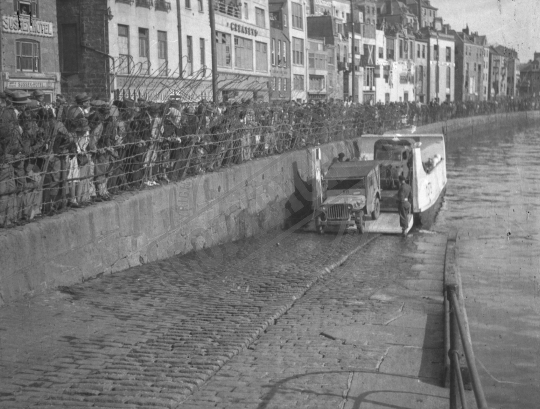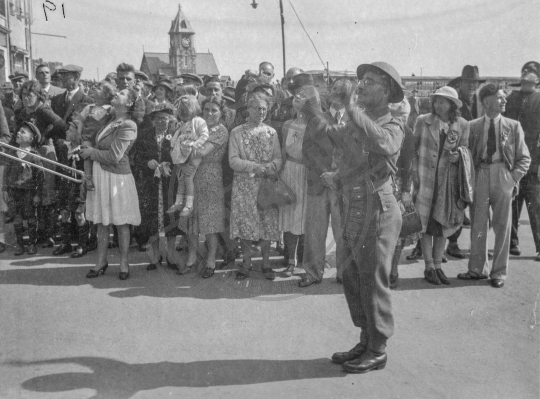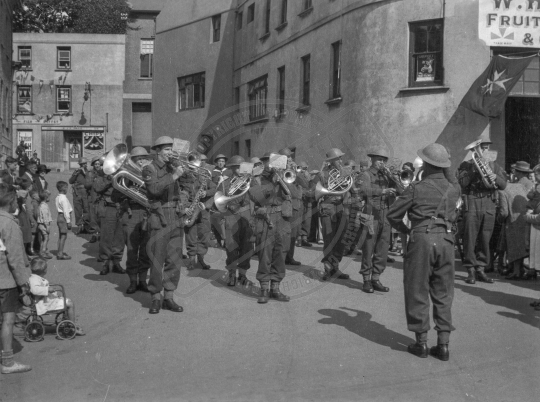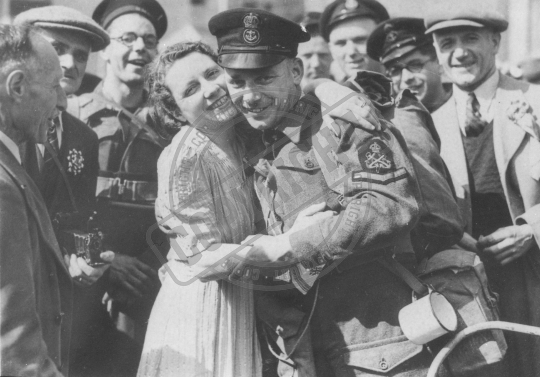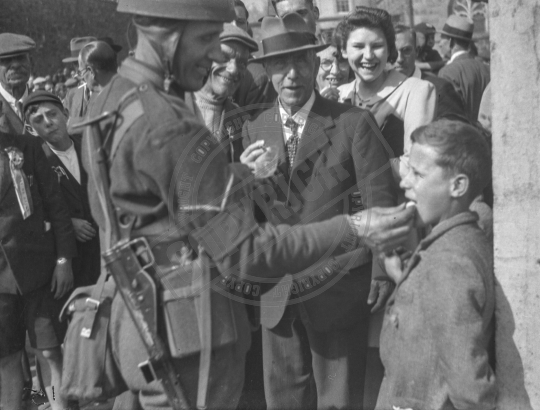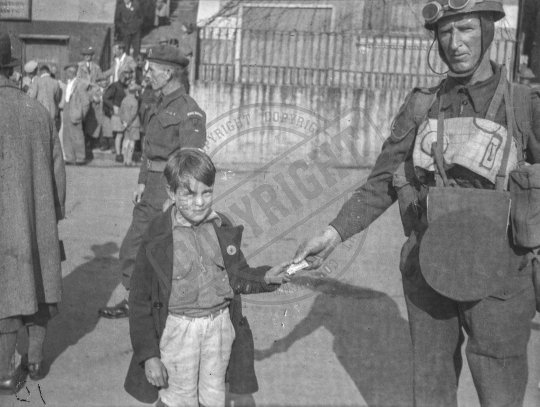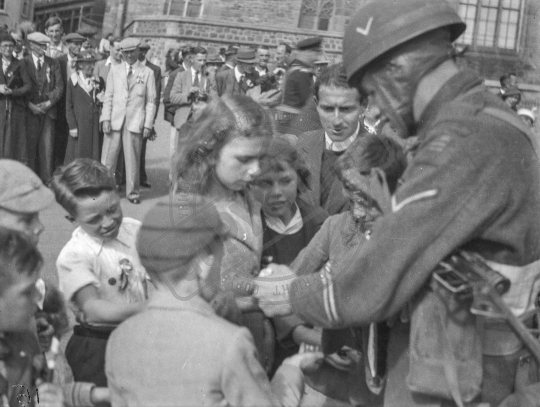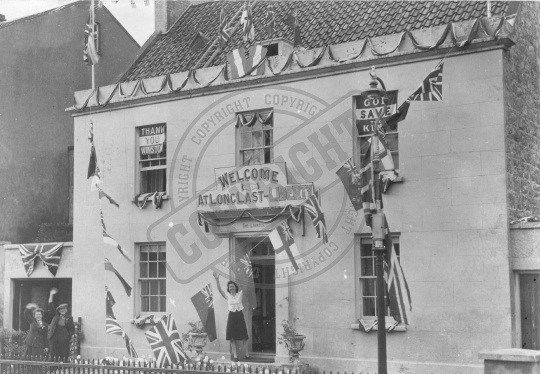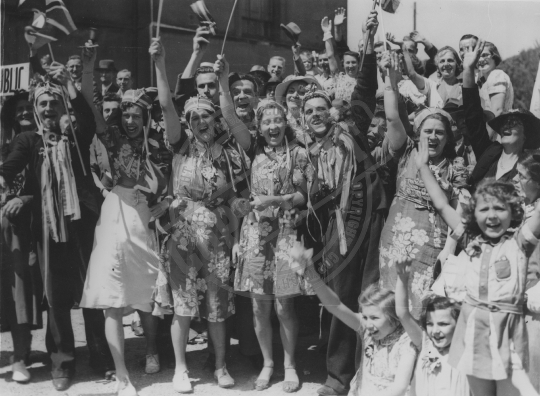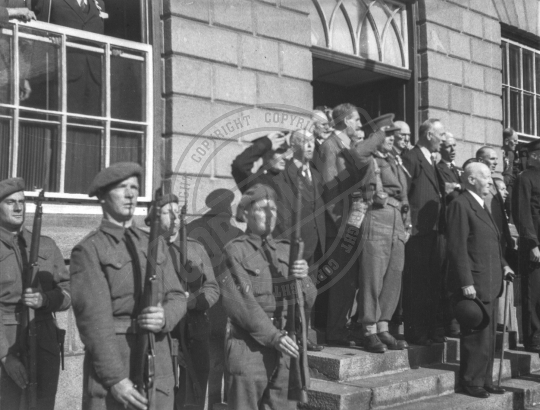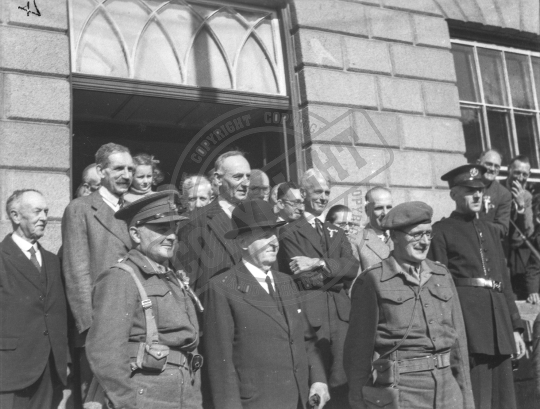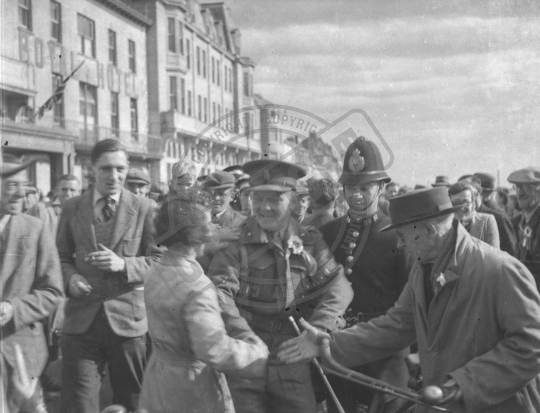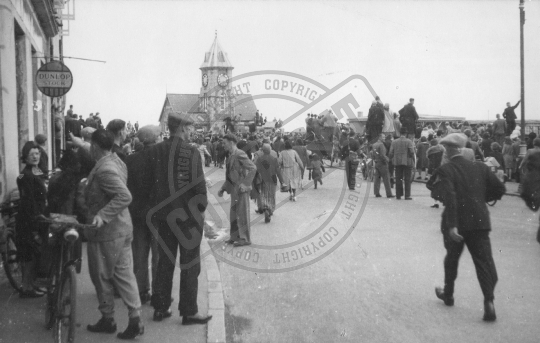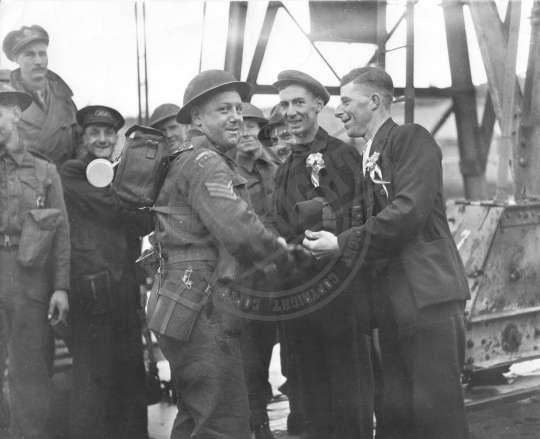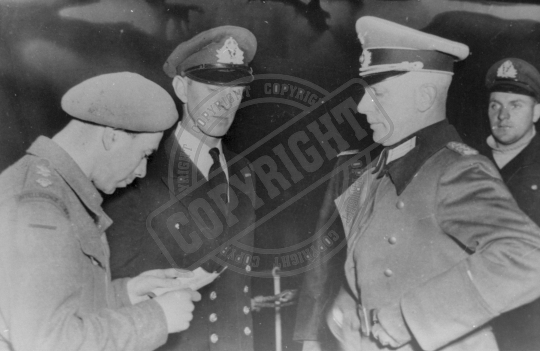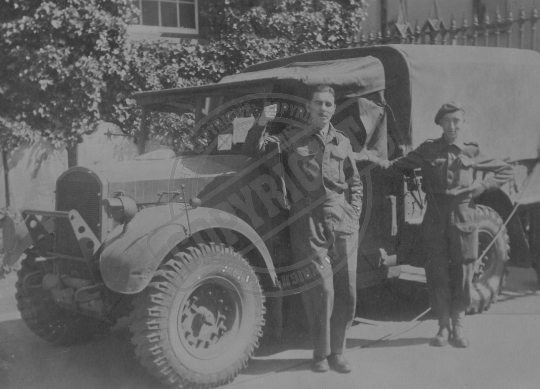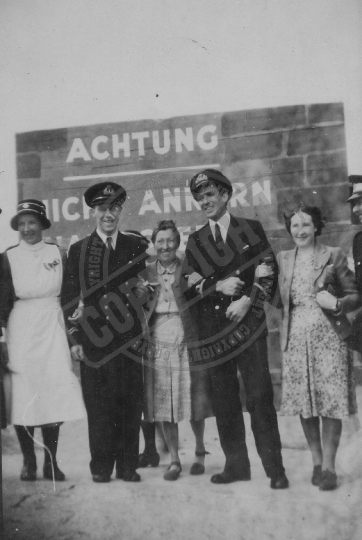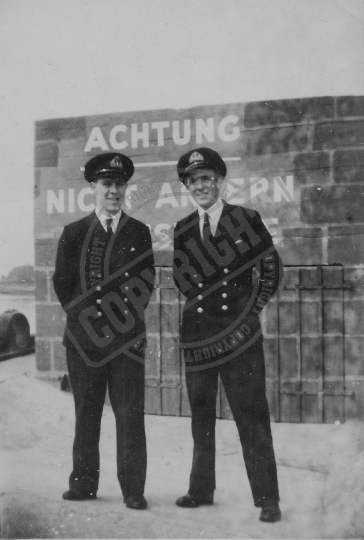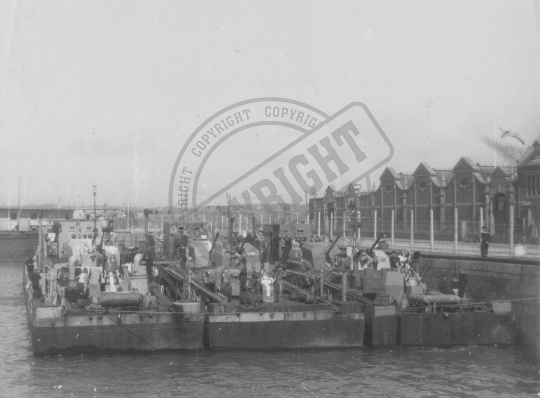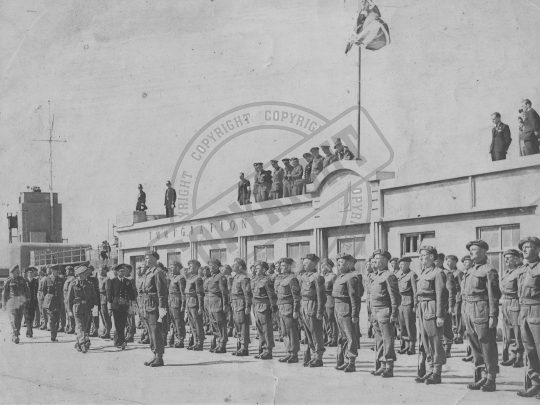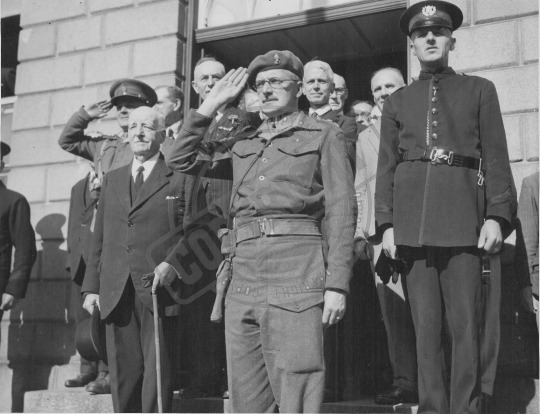Results (598)
TPL_00221
May 9th 1946. The Home Secretary Mr. Chuter Ede talking to some of the younger entrants in the Cavalcade.
TPL_00220
May 9th 1946. Recalling the vivid memories of 9th May 1945 when the two destroyers Bulldog and Beagle anchored off Guernsey was Bertram de la Mare a five-year-old sailor boy with HMS Bulldog inscribed on his cap. Behind Bertram is Kathleen Corbet covered in wood shavings making a striking “I’m a Chip off the Old Block”.
TPL_00219
May 9th 1946. Honours in the Junior Class 2 (a) in the Cavalcade for pedestrians in costume easily went to three-year-old David A. Rose, Guernsey’s “Winston Churchill” complete with top-hat cigar and walking stick made a big hit as he strolled along. He is seen here in the sidecar of Mr. F. H. Rose’s decorated motor cycle, “A Churchillian Scene” in Class 22.
TPL_00218
May 9th 1946. Youth was well to the fore with no fewer that thirty-three entered the Pedestrians in Costume (15 years and under) Class.
TPL_00217
May 9th 1946. Believed to be Elizabeth Taylor winner of the Decorated Cycles with Cyclist in Costume. Class 7, “Guernsey 1746.” Elizabeth went back before living memory to Guernsey 1746, dressed in old-fashioned costume. Behind her can be seen twelve-year-old Hazel Carré in Class 1 who had been an evacuee at St Helen’s Lancashire. She caught the eye with a decorated cycle depicting Freedom while in the same class twelve-year-old John Taylor made a fine cycling “clown”.
TPL_00216
May 9th 1946. Naval ratings from the visiting battleship HMS King George V commanded by Lieutenant-Commander Hutchins followed behind the Royal Marine Band.
TPL_00215
May 9th 1946. The Liberation Cavalcade marched in stately procession, headed by “John Bull” (Mr. Wilfred Shirvell), and moved off from the Half-Way punctually at 3 p.m.
TPL_00214
Following the Thanksgiving Service on Sunday 19th August 1945 conducted by the Rev. T. Davis, Vicar of St James, there was a march past of all the troops that had taken part in the service. Drawn from every unit in the island the troops formed up in the vicinity of the Guernsey Brewery. At 12 noon the troops proceeded along the Coal Quay and the North Esplanade then on to the Weighbridge where Brigadier A. E. Snow OBE took the salute. Beside him on the dais is the Bailiff of Guernsey Victor Carey Esq.
TPL_00213
The HM LST 365 beached in the Old Harbour, St Peter Port, Guernsey in September 1945 to collect vehicles of Force 135 and return them to the UK.
TPL_00212
In June 1940 men of military age were called upon to leave the Channel Islands and hundreds went immediately.
TPL_00211
A cargo vessel from Group III of the Liberation Fleet which arrived at St Peter Port Harbour, Guernsey, on 13th May carrying essential supplies. Once unloaded the much awaited food stuffs were transported to the Detail Issue Depot (DID), ready for distribution to islanders.
TPL_00210
SS Sandhill, Group III of the Liberation Fleet which arrived at St Peter Port Harbour, Guernsey, on 13th May carrying essential supplies. Once unloaded the much awaited food stuffs were transported to the Detail Issue Depot (DID) ready for distribution to islanders.
TPL_00209
German prisoners of war in Guernsey make their way to waiting LSTs that will take them to the England.
TPL_00208
German prisoners of war in Guernsey make their way to waiting LSTs that will take them to the England.
TPL_00207
Lines of German prisoners of war waiting on the beach to board the three LST, 295, 527 and 521 that beached in St Aubin’s Bay, Jersey, on Saturday 19th May 1945.
TPL_00206
German soldiers, now prisoners of war, waiting to embark in LST from the beach between West Park and First Tower, St Aubin’s Bay, Jersey on Saturday 19th May 1945. The US LST 295 had been part of the Second Lift bringing equipment and stores to the island on the 18th May.
TPL_00205
Wehrmacht prisoners of war proceed along Victoria Avenue to West Park, Jersey, where DUKWs were waiting on the beach to ferry them out to the LSI anchored in St Aubin’s Bay. Their eventual destination being POW camps in the UK.
TPL_00204
As Brigadier Snow was leaving the grounds of Elizabeth College following the reading of the Proclamation he caught sight of two disabled Guernseymen both proudly wearing medals, which had been gained in the World War of 1914-18. They were Mr. Arthur Henry Sims of La Rousalerie, La Ramée, St Peter Port, and Mr. F. T. Corbet, of “Guillemont”, Braye Road, St Sampson. Mr. Corbet, disabled with leg injuries at the Battle of the Somme in 1916, also received a handclasp from Brigadier Snow and said that he would cherish the kind words which the Brigadier bestowed upon him.
TPL_00203
As Brigadier Snow was leaving the grounds of Elizabeth College following the reading of the Proclamation he caught sight of two disabled Guernseymen both proudly wearing medals which had been gained in the World War of 1914-18. They were Mr. Arthur Henry Sims of La Rousalerie, La Ramée, St Peter Port, and Mr. F. T. Corbet of “Guillemont”, Braye Road, St Sampson. Brigadier Snow stopped and went across to Mr. Sims. He shook hands with him and asked him how he had lost his two legs. Mr. Sims told the Brigadier that if had happened at the Battle of Cambrai. He added that he was proud and pleased to see British boys here once again.
TPL_00202
Brigadier Snow, OBE, and his officers prepare to leave Elizabeth College grounds after the reading of the Proclamation and King’s Message Ceremony. L to R: Lieutenant-colonel E. G. Stoneman, TD, RA; Rear-Admiral C. G. Stuart, DSO, DSC (serving in the rank of Captain, RN), Naval Commander Force 135; and Brigadier A. E. Snow, OBE.
TPL_00201
Brigadier Snow and Senior Officers of Force 135 salute as the Union Flag is broken out and the DCLI Band played the National Anthem at the reading of the Proclamation and King’s Message Ceremony, at Elizabeth College, Guernsey on Saturday afternoon 12th May 1945.
TPL_00200
The RAF provided air cover for the landings and flew low over the island to “show the flag.” This squadron of fighters flew low over St Peter Port, Guernsey much to the delight of the islanders watching the British troops coming ashore. The mast of the US LST 516 can be seen which was beached in the Old Harbour.
TPL_00199
The American LST 516 beached in the Old Harbour, St Peter Port, Guernsey, on Saturday 12th May 1945. Once the tide had receded the vehicles laden with equipment and supplies disembarked.
TPL_00199
The American LST 516 beached in the Old Harbour, St Peter Port, Guernsey, on Saturday 12th May 1945. Once the tide had receded the vehicles laden with equipment and supplies disembarked.
TPL_00198
The American LST 516, piloted by Captain Abbey formerly of Isle de Serk, manoeuvred through the narrow entrance of the Inner Harbour and came to rest within a few yards of the sea wall and moored to the north and south piers of the Old Harbour and waited for the tide to recede. Tommies and Doughboys were singing and shouting and generally giving greeting to Guernsey, from the top deck. Guernsey folk are also welcoming a detachment of British Troops trying to make their way along the Esplanade.
TPL_00197
Eight DUKWs pre-loaded with supplies swam ashore from HM Landing Ship Tank (LST) 234 (Army Serial No. 130) anchored off St Peter Port, Guernsey and drove up the slipway of the Old Harbour much to the amazement of the crowd on Saturday morning 12th May 1945.
TPL_00196
During Saturday morning 12th May, several of the LSTs at anchor off St Peter Port, Guernsey lowered several British LCP(V) and other landing craft which unloaded specialist troops and their equipment. One of the landing craft is seen here unloading a Jeep and a lorry at the slipway of the Old Harbour.
TPL_00195
Warrant Officer William F. Walden-Mills, ARCM, LRAM, conducting the DCLI Band in St Peter Port on Saturday 12th May 1945.
TPL_00194
The Duke of Cornwall’s Light Infantry (DCLI) Band stops to play in the street leading from Le Pollet into the North Esplanade, St Peter Port. Their schedule was a busy one as they played at the Proclamation Ceremony at Elizabeth College during the early afternoon of Saturday 12th May 1945 and were then transported by ship to Jersey for a similar ceremony in the Royal Square, St Helier later in the day.
TPL_00193
Petty Officer John Langlois, son of Mrs. and the late Mr. Langlois, of the Green lanes, arrived in Guernsey on Saturday 12th May and before he had marched more than a few yards was greeted unexpectedly by his sister. PO Langlois, who was educated at Amherst School, joined HM forces in 1936, landed in France on D-Day and was last in the island on leave in 1939.
TPL_00191
Lance-Corporal Dispatch Rider, Force 135, putting a sweet into a boy’s mouth much to the delight of the watching crowd on the Esplanade, St Peter Port on Saturday 12th May 1945. The soldier is wearing a blue armband with the letters 'RP’ (Regimental Police) in red.
TPL_00190
Lance-Corporal Dispatch Rider, Force 135 (still wearing his life vest) offering sweets to a young Guernsey boy outside the Crown Hotel on the Esplanade, St Peter Port on Saturday 12th May 1945.
TPL_00189
Lance-Corporal Dispatch Rider, Force 135, giving out sweets to a group of delighted children on the Esplanade, St Peter Port on Saturday 12th May 1945.
TPL_00188
Mrs. Elsie Jory of the Laurels Candie Road St Peter Port had painted her 'Welcome’ sign under the very noses of the Germans in her husband’s workshops whilst he had planted out 150 red and 150 white tulips the previous October.
TPL_00187
A crowd of joyous Guernsey islanders in front of the States building in St Peter Port on May 9th 1945.
TPL_00186
The Guard of Honour present arms, the officers salute and the Bailiff removes his Bowler hat as the Union Flag is broken out at the Hoisting of the Flag Ceremony outside the Court Buildings.
TPL_00185
Gathered with Guernsey States officials on the Court House steps for the Hoisting of the Flag Ceremony are (left to right front row) Colonel H. R. Power, OBE, MC, No. 20 Civil Affairs Unit; the Bailiff of Guernsey, Mr. Victor Carey; Lieutenant-Colonel E. G. Stoneman, TD, RA, officer commanding 618 Regiment, Royal Artillery, Force 135.
TPL_00184
Colonel Herbert Power OBE, MC, Chief Civil Affairs Officer, No. 20 Civil Affairs Unit, Force 135, makes little headway along the Glategny Esplanade after leaving the Royal Hotel. He was besieged by thankful islanders wanting to shake his hand and obtain his autograph. PC 24 Basil Le Page tries to help him through the enthusiastic crowd.
TPL_00183
Crowds of Guernsey folk that had waited for the arrival of the main body of the 'Omelette’ advance party climbed on buildings, carts and lorries to get a better view. At 2.15 p.m. on Wednesday 9th May 1945 the British troops landed under the command of Major J. Clement, RA, consisting of 'D’ Battery 618 Regiment, Royal artillery, with additional personnel from 'A’ Battery; Detachment of Royal Engineers; Detachment of royal Corps of Signals; totalling eleven officers, three Warrant Officers and one hundred and fifty four other ranks.
TPL_00182
Sergeant 'Nobby’ Hamon, Hampshires, attached to 618 Regiment, Royal Artillery. A well-known island footballer before the war who landed with the initial troops from the 'Omelette’ advance party at the New Jetty St Peter Port Harbour on Wednesday 9th May 1945 at approximately 07.50 hours. He is being greeted by Mr. Walter Le Fevre and Mr. Philip Hamon from Sark as he stepped ashore.
TPL_00181
Generalmajor Siegfried Heine boarding HMS Bulldog just after midnight on Wednesday 9th May presents his Identification Authorisation to Captain H. Herzmark of the Intelligence Corps. He was escorted to the Wardroom to meet with the three British representatives to discuss the technicalities of surrender.
OA_075
Royal Visit, Jersey, Thursday morning, 7th June, 1945. The St Helier Harbourmaster, Captain Harry Richmond, chats with another local harbour official on the Albert Pier as they wait for their Majesties’ arrival.
OA_073
Royal Visit, Jersey, Thursday, 7th June, 1945. A Ford 1-cwt recording truck used by the BBC correspondents for the Royal Visit parked in St Helier Church Yard, opposite the entrance of the new States buildings. The man on the left is a War Correspondent, possibly Howard Marshall’s Recording Engineer W. S. Costello, and the soldier on the right is most probably the driver of the truck. On the windscreen can be seen displayed the Royal Visit St Patrick’s Cross vehicle permit, issued by Force 135 HQ, and another identifying the truck as belonging to the BBC.
OA_072
Surgeon-Lieutenant Ronald McDonald, RNVR, and Sub-Lieutenant David Milln, RN, shortly after landing at the end of the Albert Pier, St Helier, Harbour, Jersey, on Wednesday morning 9th May, 1945. Welcoming them ashore are L to R: Mary Marteret, Miss Frazer, unknown, and just in the picture Major Cooke.
OA_071
Surgeon-Lieutenant Ronald McDonald, RNVR, and Sub-Lieutenant David Milln, RN, shortly after landing at the end of the Albert Pier, St Helier, Harbour, Jersey, on Wednesday morning 9th May, 1945. The German sign behind them advises Achtung Nicht Ankern Hafenspere (Attention No Anchoring Harbour Boom).
OA_070
Surgeon-Lieutenant Ronald McDonald, RNVR, and Sub-Lieutenant David Milln, RN, shortly after landing at the end of the Albert Pier, St Helier, Harbour, Jersey, on Wednesday morning 9th May, 1945. Welcoming them ashore are L to R: Betty Richomme, Miss Haines, back row unknown, Mary Marteret, Mrs. M. Sewell, Miss Frazer, unknown, Maurice Gautier, Major Cooke, Mr. Hibbs Royal Court Usher, last three unknown.
OA_068
Three German Artillery Carriers (Artillerieträger), AF 65, 68 and 71 moored at the top of the New North Quay, St Helier Harbour, Jersey, on 12th May, 1945. In the foreground can be seen the top of a British Landing Craft.
OA_064
Royal Visit, Jersey, Thursday morning, 7th June, 1945. His Majesty, King George VI, and Major E. E. Underwood, RA, Guard Commander, inspect the Guard of honour lined up in front of the Immigration Building on the Albert Pier, St Helier Harbour. Lieutenant-General Kidman, Brigadier Snow and Lieutenant-Colonel Robinson follow behind. The troops were members of 'B’ Battery, 614 Regiment, Royal Artillery. On the roof of the immigration building are local Police Officers and a group of war correspondents.
OA_062
The Hoisting of the Flag Ceremony at the Court House, St Peter Port, Guernsey, on Wednesday morning, 9th May, 1945. The two British officers from Force 135, Colonel Power and Lt-Col Stoneman salute, the Bailiff of Guernsey removed his bowler hat and Members of the Controlling Committee of the States of Guernsey look on as the Union Jack is raised after five years of German Occupation.



